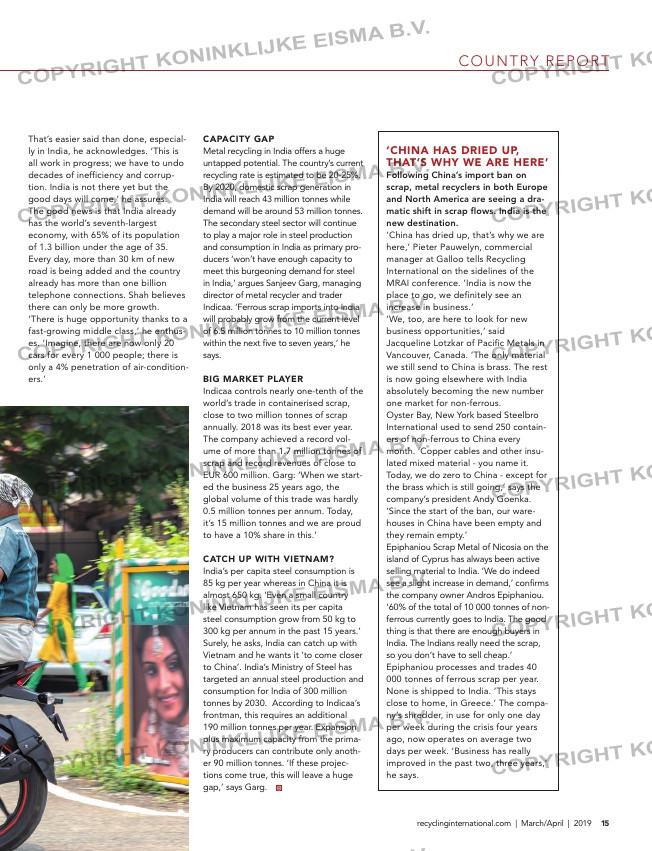Page 15 from: New issue out now!

COUNTRY REPORT
15recyclinginternational.com | March/April | 2019
That’s easier said than done, especial-
ly in India, he acknowledges. ‘This is
all work in progress; we have to undo
decades of inefficiency and corrup-
tion. India is not there yet but the
good days will come,’ he assures.
The good news is that India already
has the world’s seventh-largest
economy, with 65% of its population
of 1.3 billion under the age of 35.
Every day, more than 30 km of new
road is being added and the country
already has more than one billion
telephone connections. Shah believes
there can only be more growth.
‘There is huge opportunity thanks to a
fast-growing middle class,’ he enthus-
es. ‘Imagine, there are now only 20
cars for every 1 000 people; there is
only a 4% penetration of air-condition-
ers.’
CapaCity gap
Metal recycling in India offers a huge
untapped potential. The country’s current
recycling rate is estimated to be 20-25%.
By 2020, domestic scrap generation in
India will reach 43 million tonnes while
demand will be around 53 million tonnes.
The secondary steel sector will continue
to play a major role in steel production
and consumption in India as primary pro-
ducers ‘won’t have enough capacity to
meet this burgeoning demand for steel
in India,’ argues Sanjeev Garg, managing
director of metal recycler and trader
Indicaa. ‘Ferrous scrap imports into India
will probably grow from the current level
of 6.5 million tonnes to 10 million tonnes
within the next five to seven years,’ he
says.
Big market player
Indicaa controls nearly one-tenth of the
world’s trade in containerised scrap,
close to two million tonnes of scrap
annually. 2018 was its best ever year.
The company achieved a record vol-
ume of more than 1.7 million tonnes of
scrap and record revenues of close to
EUR 600 million. Garg: ‘When we start-
ed the business 25 years ago, the
global volume of this trade was hardly
0.5 million tonnes per annum. Today,
it’s 15 million tonnes and we are proud
to have a 10% share in this.’
CatCh up with Vietnam?
India’s per capita steel consumption is
85 kg per year whereas in China it is
almost 650 kg. ‘Even a small country
like Vietnam has seen its per capita
steel consumption grow from 50 kg to
300 kg per annum in the past 15 years.’
Surely, he asks, India can catch up with
Vietnam and he wants it ‘to come closer
to China’. India’s Ministry of Steel has
targeted an annual steel production and
consumption for India of 300 million
tonnes by 2030. According to Indicaa’s
frontman, this requires an additional
190 million tonnes per year. Expansion
plus maximum capacity from the prima-
ry producers can contribute only anoth-
er 90 million tonnes. ‘If these projec-
tions come true, this will leave a huge
gap,’ says Garg.
‘China has dried up,
that’s why we are here’
Following China’s import ban on
scrap, metal recyclers in both Europe
and North america are seeing a dra-
matic shift in scrap flows. India is the
new destination.
‘China has dried up, that’s why we are
here,’ Pieter Pauwelyn, commercial
manager at Galloo tells Recycling
International on the sidelines of the
MRAI conference. ‘India is now the
place to go, we definitely see an
increase in business.’
‘We, too, are here to look for new
business opportunities,’ said
Jacqueline Lotzkar of Pacific Metals in
Vancouver, Canada. ‘The only material
we still send to China is brass. The rest
is now going elsewhere with India
absolutely becoming the new number
one market for non-ferrous.
Oyster Bay, New York based Steelbro
International used to send 250 contain-
ers of non-ferrous to China every
month. ‘Copper cables and other insu-
lated mixed material – you name it.
Today, we do zero to China – except for
the brass which is still going,’ says the
company’s president Andy Goenka.
‘Since the start of the ban, our ware-
houses in China have been empty and
they remain empty.’
Epiphaniou Scrap Metal of Nicosia on the
island of Cyprus has always been active
selling material to India. ‘We do indeed
see a slight increase in demand,’ confirms
the company owner Andros Epiphaniou.
‘60% of the total of 10 000 tonnes of non-
ferrous currently goes to India. The good
thing is that there are enough buyers in
India. The Indians really need the scrap,
so you don’t have to sell cheap.’
Epiphaniou processes and trades 40
000 tonnes of ferrous scrap per year.
None is shipped to India. ‘This stays
close to home, in Greece.’ The compa-
ny’s shredder, in use for only one day
per week during the crisis four years
ago, now operates on average two
days per week. ‘Business has really
improved in the past two, three years,’
he says.
14-15-16-18-19-20-22-23_countryreport-india.indd 15 14-03-19 09:55



